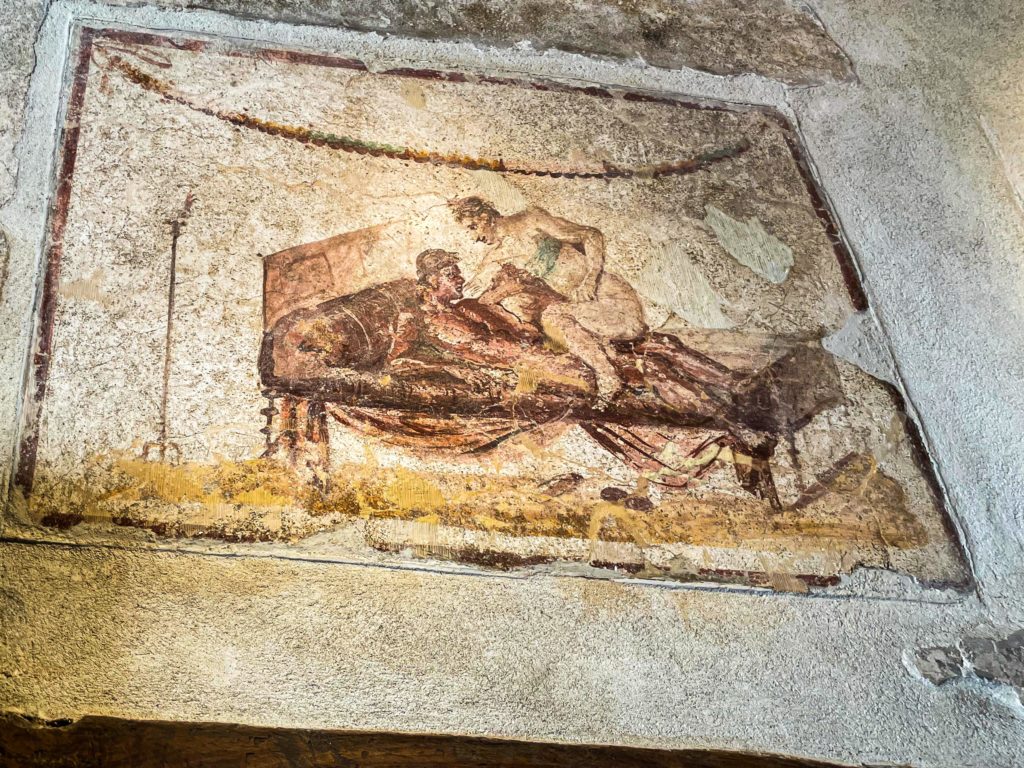January 2022

Lello, our knowledgeable guide and sometime history teacher, takes us to an impressive two-story structure as part of the morning tour of ancient Pompeii in Southern Italy. His round, wire-rimmed glasses accentuate his round face as he animates fascinating details of Pompeiian life. So far, I’m gob smacked with touring the city’s well-preserved ruins from antiquity. Hot ash encased the city and its inhabitants, preserving an extraordinary amount of stone structure, artwork, wall murals, pottery, and other material traces of daily life. Approaching Lupanar Grande, Pompeii’s once “official” brothel, Lello shows us several phalluses carved into stones on the street surfaces and walls that “point” the way to the brothels.
Was Pompeii full of brothels?
Standing in the narrow hallway of Lupanar Grande, I stare at a menu, a row of tiles–many faded, some in good condition–yet all once artfully descriptive of various sexual acts available for purchase. Five tiny, windowless rooms off the hallway each contain a stone bed and pillow occupying much of the space. Their thinly stuffed mattresses of hay, wool, and straw were destroyed by the 20 feet of Mount Vesuvius’ intense heat and ash that buried Pompeii in 79 A.D. Five more rooms occupy the second floor, making this brothel the largest of 25 discovered to date in this once-wealthy, cosmopolitan city.
Many believe fire from high heat killed the inhabitants. But a combination of fast-moving ash and deadly gas clouds, called pyroclastic surges, released from the superheated lava speeding down the mountain; the suspended clouds asphyxiated 2,000 Pompeiians a hellish 15 minutes later.
Did Romans have pornography?
However, the ash did preserve large wall murals of carnal activities on the brothel walls as well as these explicit wall tiles.
As I absorb the atmosphere of Lupanar Grande, I feel as if I’m witnessing a 2000-year-old conversation.
INTERIOR. LUPANER BROTHEL—EVENING
The Lupanar brothel, a lively place of noise, drink, and an undercurrent of music and satisfaction. Lupanar is the top brothel in ancient Pompeii. Fulvia reigns as customers arrive
Fulvia:
Lupanar’s Madam speaks Latin.
Bene vesperi, domine. (Good evening, sir.)
I see you’ve been enjoying our local pub.
Did your ship arrive in port today?
Oclinus:
A Gaulish trader, drinking a large quantity of honeyed wine, staggers toward Fulvia, speaking his native tongue.
My dear Madam, I don’t understand a word you’re saying.
I’m here to spend a little time with a beautiful young lady.
He makes a crude gesture with his hips.
I observe a lovely, slender African woman descend steps from the upper quarters and walk to Fulvia.
As she approaches, I see that her forearms are half-covered in jingling bracelets.
Fulvia:
Turns to Portia, speaking Latin
This guy is drunk as a skunk, and he stinks, too.
But his clothing also reeks of deep pockets.
I’ll find out what he’s in the mood for.
She turns to Oclinus, points to a series of inlaid glazed tiles lining the wall.
How can one of our lovely girls serve you? Choose from our menu, please.
Oclinus:
Weaves, licks his lips, and points to a tile with a man and woman lying on a bed, limbs entangled.
I want that one!
Fulvia:
Addresses Portia
Ah, he wants the Round-the-World special.
That’ll cost him twenty denarii! First, I’ll collect his money, then you take him upstairs to the Oriental girl. She’ll show him a good time.
With negotiations completed, the scene evaporates.
How did Roman brothels work?
Before the advent of Christianity’s religious and political hegemony over western civilization, Greek and Roman cultures attached little taboo to the range of human sexual activities—including prostitution. At first, I admire Roman cultural norms that provided for this form of human expression. With nearby Naples a major Mediterranean seaport, the brothels also attracted foreign seafarers and traveling businessmen. Language often presented challenging negotiations. Colorful, explicit wall tiles and murals in the City of Pompeii brothels provided a universally understood menu of services.
Brothels were businesses run by owners, or lenos, who paid almost nothing to the prostitutes, called lupas. (Lupanar means “wolf-den.”) And here my fleeting admiration ends. All sex workers––young women and men––were slaves. And the slaves often came from far-flung conquered Roman territories, abducted at the site of Roman victories, or sold into slavery by starving families who needed money. They even included once-married women punished for infidelity. Lupas spent most of their time in these tiny dark rooms enduring or succumbing to abuse and torture. Lenos provided them the barest minimum of food, clothing, and shelter.
Sex workers clung to the lowest rungs of the social ladder, suffering diseases transmitted by customers and harsh living conditions. Owners controlled every aspect of their slaves’ lives until they were no longer useful. Then the lenos turned them onto the streets; rarely they were fortunate enough to be sent to work on huge farming estates.
A fresh, excited crowd enters the front of the building and I’m pushed out the back door. Fifteen minutes ago, the prospect of visiting the brothel titillated me. Now I feel sad about this broad ugly streak of cruelty plaguing humanity. It turns out that many of the “heroes” from our childhood history and adventure books were in truth the bad guys.

